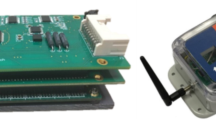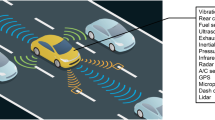Abstract
Advances in sensor technologies, data management and identification/detection algorithms have led to significant advances in condition monitoring of transportation infrastructure in the last four decades. Sensor-based condition monitoring identifies damage sensitive features from measurements. While the vast majority of condition monitoring research relies on dedicated and stationary sensor positioning, there is an emerging paradigm with so called drive-by condition monitoring that detects infrastructure damage from sensors embedded in moving vehicles. With the advent of mobile and smart technologies, drive-by condition monitoring has gained pace and is now among the most promising condition monitoring concepts. Unlike traditional dedicated approaches, drive-by condition monitoring can scan multiple bridges due to vehicle mobility and can provide spatially high-resolution readings from infrastructures, e.g., kilometres-long railway tracks. However, there are numerous challenges that limit the applicability of drive-by, such as the short duration of sample segments and the masking of infrastructure-induced vibrations by much larger vehicle-induced measurements. This chapter presents a brief state-of-the-art of drive-by condition monitoring with a focus on railway infrastructure, sheds light on the current trends, and proposes future directions that are likely to shape the next decade’s drive-by condition monitoring research from the authors’ perspectives.
Access this chapter
Tax calculation will be finalised at checkout
Purchases are for personal use only
Similar content being viewed by others
References
Alavi AH, Buttlar WG (2019) An overview of smartphone technology for citizen-centered, real-time and scalable civil infrastructure monitoring. Futur Gener Comput Syst 93:651–672
Barke D, Chiu WK (2005) Structural health monitoring in the railway industry: a review. Struct Health Monit 4(1):81–93
Chang KC, Wu FB, Yang YB (2010) Effect of road surface roughness on indirect approach for measuring bridge frequencies from a passing vehicle. Interact Multiscale Mech 3(4):299–308
Chuang TY, Perng NH, Han JY (2019) Pavement performance monitoring and anomaly recognition based on crowdsourcing spatiotemporal data. Autom Constr 106:102882
Corbally R, Malekjafarian A (2021) Examining changes in bridge frequency due to damage using the contact-point response of a passing vehicle. J Struct Integr Maint 6(3):148–158
Corbally R, Malekjafarian A (2022) A data-driven approach for drive-by damage detection in bridges considering the influence of temperature change. Eng Struct 253:113783
Corbally R (2023) A machine learning approach for drive-by condition monitoring of bridges. PhD Dissertation. University College Dublin, Dublin, Ireland
Elhattab A, Uddin N, OBrien E (2016) Drive-by bridge damage monitoring using bridge displacement profile difference. J Civ Struct Heal Monit 6:839–850
Farrar CR, Worden K (2007) An introduction to structural health monitoring. Philos Trans R Soc A: Math Phys Eng Sci 365(1851):303–315
Feng M, Fukuda Y, Mizuta M, Ozer E (2015) Citizen sensors for SHM: use of accelerometer data from smartphones. Sensors 15(2):2980–2998
Fitzgerald PC, Malekjafarian A, Cantero D, OBrien EJ, Prendergast LJ (2019) Drive-by scour monitoring of railway bridges using a wavelet-based approach. Eng Struct 191:1–11
González A, OBrien EJ, Li YY, Cashell K (2008) The use of vehicle acceleration measurements to estimate road roughness. Veh Syst Dyn 46(6):483–499
González A, OBrien EJ, McGetrick PJ (2012) Identification of dam** in a bridge using a moving instrumented vehicle. J Sound Vib 331(18):4115–4131
Huang K, Yuen KV (2020) Online decentralized parameter estimation of structural systems using asynchronous data. Mech Syst Signal Process 145:106933
** N, Yang YB, Dimitrakopoulos EG, Paraskeva TS, Katafygiotis LS (2021) Application of short-time stochastic subspace identification to estimate bridge frequencies from a traversing vehicle. Eng Struct 230:111688
Keenahan J, Ren Y, Brien EJ (2019) Determination of road profile using multiple passing vehicle measurements. Struct Infrastruct Eng 16(9):1262–1275
Lederman G, Chen S, Garrett J, Kovačević J, Noh HY, Bielak J (2017) Track-monitoring from the dynamic response of an operational train. Mech Syst Signal Process 87:1–16
Li C, He Q, Wang P (2022) Estimation of railway track longitudinal irregularity using vehicle response with information compression and Bayesian deep learning. Comput-Aided Civ Infrastruct Eng 37(10):1260–1276
Li J, Zhu X, Guo J (2022) Enhanced drive-by bridge modal identification via dual Kalman filter and singular spectrum analysis. Struct Control Health Monit 29(5):e2927
Locke W, Sybrandt J, Redmond L, Safro I, Atamturktur S (2020) Using drive-by health monitoring to detect bridge damage considering environmental and operational effects. J Sound Vib 468:115088
Lynch JP, Loh KJ (2006) A summary review of wireless sensors and sensor networks for structural health monitoring. Shock Vib Digest 38(2):91–130
Malekjafarian A, OBrien EJ (2014) Identification of bridge mode shapes using short time frequency domain decomposition of the responses measured in a passing vehicle. Eng Struct 81:386–397
Malekjafarian A, McGetrick PJ, OBrien EJ (2015) A review of indirect bridge monitoring using passing vehicles. Shock Vib
Malekjafarian A, OBrien EJ (2017) On the use of a passing vehicle for the estimation of bridge mode shapes. J Sound Vib 397:77–91
Malekjafarian A, OBrien EJ, Quirke P, Bowe C (2019) Railway track monitoring using train measurements: An experimental case study. Appl Sci 9(22):4859
Malekjafarian A, OBrien EJ, Quirke P, Cantero D, Golpayegani F (2021) Railway track loss-of-stiffness detection using bogie filtered displacement data measured on a passing train. Infrastructures 6(6):93
Malekjafarian A, Khan MA, OBrien EJ, Micu EA, Bowe C, Ghiasi R (2022) Indirect monitoring of frequencies of a multiple span bridge using data collected from an instrumented train: a field case study. Sensors 22(19):7468
Malekjafarian A, Corbally R, Gong W (2022) A review of mobile sensing of bridges using moving vehicles: progress to date, challenges and future trends. Structures 44:1466–1489
Malekloo A, Ozer E, AlHamaydeh M, Girolami M (2022) Machine learning and structural health monitoring overview with emerging technology and high-dimensional data source highlights. Struct Health Monit 21(4):1906–1955
Matarazzo TJ, Santi P, Pakzad SN, Carter K, Ratti C, Moaveni B, Osgood C, Jacob N (2018) Crowdsensing framework for monitoring bridge vibrations using moving smartphones. Proc IEEE 106(4):577–593
Mei Q, Gül M (2019) A crowdsourcing-based methodology using smartphones for bridge health monitoring. Struct Health Monit 18(5–6):1602–1619
Micu EA, OBrien EJ, Bowe C, Fitzgerald P, Pakrashi V (2022) Bridge damage and repair detection using an instrumented train. J Bridg Eng 27(3):05021018
Miura S, Takai H, Uchida M, Fukada Y (1998) The mechanism of railway tracks. Jpn Railw & Transp Rev 3(38–45):54
OBrien EJ, Keenahan J (2015) Drive-by damage detection in bridges using the apparent profile. Struct Control Health Monit 22(5):813–825
OBrien EJ, Quirke P, Bowe C, Cantero D (2018) Determination of railway track longitudinal profile using measured inertial response of an in-service railway vehicle. Struct Health Monit 17(6):1425–1440
OBrien EJ, McCrum DP, Wang S (2023) Drive-by fleet monitoring to detect bearing damage in bridges using a moving reference influence function. Int J Struct Stab Dyn
Ozer E, Purasinghe R, Feng MQ (2020) Multi-output modal identification of landmark suspension bridges with distributed smartphone data: Golden Gate Bridge. Struct Control Health Monit 27(10):e2576
Zhang Y, Lie ST, **ang Z (2013) Damage detection method based on operating deflection shape curvature extracted from dynamic response of a passing vehicle. Mech Syst Signal Process 35(1–2):238–254
Ozer E, Feng MQ (2016) Synthesizing spatiotemporally sparse smartphone sensor data for bridge modal identification. Smart Mater Struct 25(8):085007
Ozer E, Malekloo A, Ramadan W, Tran TT, Di X (2022) Systemic reliability of bridge networks with mobile sensing‐based model updating for postevent transportation decisions. Comput‐Aided Civ Infrastruct Eng
Ozer E, Feng MQ (2017) Direction-sensitive smart monitoring of structures using heterogeneous smartphone sensor data and coordinate system transformation. Smart Mater Struct 26(4):045026
Ozer E, Feng MQ, Feng D (2015) Citizen sensors for SHM: towards a crowdsourcing platform. Sensors 15(6):14591–14614
Quirke P (2017) Drive-by detection of railway track longitudinal profile, stiffness and bridge damage. PhD dissertation. University College Dublin, Dublin, Ireland
Quirke P, OBrien EJ, Bowe C, Cantero D, Malekjafarian A (2022) The calibration challenge when inferring longitudinal track profile from the inertial response of an in-service train. Can J Civ Eng 49(2):274–288
Rao ARM, Kasireddy V, Gopalakrishnan N, Lakshmi K (2015) Sensor fault detection in structural health monitoring using null subspace–based approach. J Intell Mater Syst Struct 26(2):172–185
Ren Y, OBrien EJ, Cantero D, Keenahan J (2022) Railway bridge condition monitoring using numerically calculated responses from batches of trains. Appl Sci 12(10):4972
Spencer BF, Jo H, Mechitov KA, Li J, Sim SH, Kim RE, Cho S, Linderman LE, Moinzadeh P, Giles RK, Agha G (2016) Recent advances in wireless smart sensors for multi-scale monitoring and control of civil infrastructure. J Civ Struct Health Monit 6:17–41
Tan C, Elhattab A, Uddin N (2017) Drive-by bridge frequency-based monitoring utilizing wavelet transform. J Civ Struct Heal Monit 7:615–625
Tan C, Uddin N (2020) Hilbert transform based approach to improve extraction of drive-by bridge frequency. Smart Struct Syst 25(3)
Tola S, Tinoco J, Matos JC, OBrien EJ (2023) Scour detection with monitoring methods and machine learning algorithms—a critical review. Appl Sci 13(3):1661
Tran TT, Ozer E (2020) Automated and model-free bridge damage indicators with simultaneous multiparameter modal anomaly detection. Sensors 20(17):4752
Tran TT, Ozer E (2021) Synergistic bridge modal analysis using frequency domain decomposition, observer Kalman filter identification, stochastic subspace identification, system realization using information matrix, and autoregressive exogenous model. Mech Syst Signal Process 160:107818
Wang S (2023) Bridge health monitoring using moving force identification and a fleet of partially instrumented vehicles. PhD dissertation. University College Dublin, Dublin, Ireland
Weston P, Roberts C, Yeo G, Stewart E (2015) Perspectives on railway track geometry condition monitoring from in-service railway vehicles. Veh Syst Dyn 53(7):1063–1091
Yang YB, Lin CW, Yau JD (2004) Extracting bridge frequencies from the dynamic response of a passing vehicle. J Sound Vib 272(3–5):471–493
Yang YB, Li YC, Chang KC (2012) Effect of road surface roughness on the response of a moving vehicle for identification of bridge frequencies. Interact Multiscale Mech 5(4):347–368
Yang YB, Li YC, Chang KC (2014) Constructing the mode shapes of a bridge from a passing vehicle: a theoretical study. Smart Struct Syst 13(5):797–819
Yang YB, Yang JP (2018) State-of-the-art review on modal identification and damage detection of bridges by moving test vehicles. Int J Struct Stab Dyn 18(02):1850025
Yang YB, Zhang B, Qian Y, Wu Y (2018) Contact-point response for modal identification of bridges by a moving test vehicle. Int J Struct Stab Dyn 18(05):1850073
Yang YB, Wang ZL, Shi K, Xu H, Wu YT (2020) State-of-the-art of vehicle-based methods for detecting various properties of highway bridges and railway tracks. Int J Struct Stab Dyn 20(13):2041004
Yang YB, Wang BQ, Wang ZL, Shi K, Xu H, Zhang B, Wu YT (2020) Bridge surface roughness identified from the displacement influence lines of the contact points by two connected vehicles. Int J Struct Stab Dyn 20(14):2043003
Yang YB, **ong F, Wang ZL, Xu H (2020) Extraction of bridge frequencies inclusive of the higher modes by the ESMD using the contact-point response. Int J Struct Stab Dyn 20(04):2050045
Author information
Authors and Affiliations
Corresponding author
Editor information
Editors and Affiliations
Rights and permissions
Copyright information
© 2024 The Author(s), under exclusive license to Springer Nature Switzerland AG
About this chapter
Cite this chapter
Ozer, E., OBrien, E. (2024). Drive-By Methodologies for Smart Condition Monitoring of Railway Infrastructure. In: Ribeiro, D., Montenegro, P.A., Andersson, A., Martínez-Rodrigo, M.D. (eds) Digital Railway Infrastructure. Digital Innovations in Architecture, Engineering and Construction. Springer, Cham. https://doi.org/10.1007/978-3-031-49589-2_7
Download citation
DOI: https://doi.org/10.1007/978-3-031-49589-2_7
Published:
Publisher Name: Springer, Cham
Print ISBN: 978-3-031-49588-5
Online ISBN: 978-3-031-49589-2
eBook Packages: Computer ScienceComputer Science (R0)




